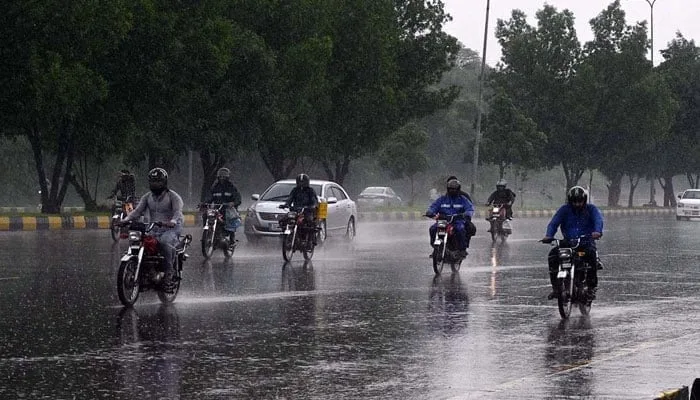KARACHI: Light rain and drizzling in parts of Karachi on Monday brought much-needed relief from the persistent heat and humidity. Areas such as Malir, Memon Goth, Model Colony, Bufferzone, and Shahrah-e-Faisal received light showers in the early hours, followed by cooler, pleasant weather conditions across the city.
According to the Pakistan Meteorological Department (PMD), more drizzling or light rain is expected in the city’s coastal belt through the day, as moist monsoon currents continue to push inland.
Local commuters reported slightly wet roads, but there were no major disruptions in traffic during the morning hours.
Rain, Winds Forecast in Several Sindh Districts
Beyond Karachi, the Met Office has issued a rainfall alert for several districts across Sindh, warning of showers accompanied by strong winds. The affected areas include Tharparkar, Umerkot, Badin, Dadu, Sukkur, Jacobabad, Larkana, Kashmore, and Shikarpur.
These showers are expected to occur intermittently throughout Monday, as monsoon moisture continues to move into southern Pakistan.
Meanwhile, other regions of Sindh are still under hot and humid conditions, with no immediate signs of rainfall relief. However, weather experts say these areas may also witness a change in weather patterns over the next few days.
NDMA Issues Nationwide Monsoon Alert, Warns of Rising Flood Threat
Monsoon Activity to Intensify Nationwide from July 5
Earlier, the PMD predicted that the monsoon system would intensify across the country starting from July 5, as moist currents from the Arabian Sea and Bay of Bengal strengthen their influence over Pakistan’s upper and central regions.
According to the latest advisory:
-
Balochistan is expected to receive rainfall from July 6 to 8, particularly in the northeastern and southern parts.
-
Kashmir and Khyber-Pakhtunkhwa will see widespread rainfall, wind, and thunderstorms from July 5 to 10, with some areas expecting heavy to very heavy downpours.
-
Gilgit-Baltistan is likely to receive rain from July 6 to 10, with breaks in between.
-
Punjab and Islamabad will witness scattered rain, wind, and thunderstorms from July 5 to 10, with some heavy falls predicted.
-
In southern Punjab, districts such as Bahawalpur, Bahawalnagar, Multan, D.G. Khan, Khanewal, Lodhran, Muzaffargarh, Rajanpur, Rahim Yar Khan, and Layyah are expected to receive rainfall from July 6 to 8.
The Met Office has advised farmers and citizens to stay alert and take necessary precautions, especially in areas vulnerable to urban flooding and landslides.
As the monsoon gains strength, authorities are monitoring weather developments closely, with a focus on flood preparedness and public safety.
Follow us on Instagram, YouTube, Facebook,, X and TikTok for latest updates
